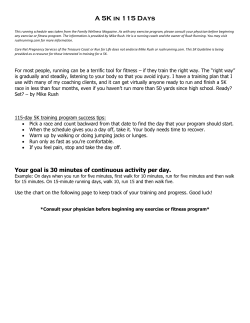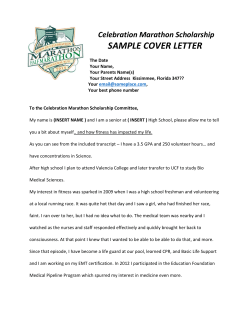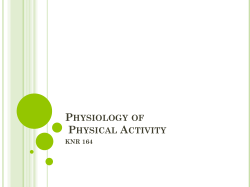
Basic Principles of Physical Fitness Chapter 2
Basic Principles of Physical Fitness Chapter 2 Physical Activity and Exercise for Health and Fitness Physical activity levels have declined Healthy People 2010: More than 55% of U.S. adults do not engage in recommended amounts of activity 25% are not active at all Levels of Physical Activity Physical Activity on a Continuum Physical activity: any body movement carried out by the skeletal muscles and requiring energy Exercise: planned, structured, repetitive movement of the body designed to improve or maintain physical fitness Physical fitness: a set of physical attributes that allows the body to respond or adapt to the demands and stress of physical effort Lifestyle Physical Activity For health promotion: Expend about 150 calories—equivalent to 30 minutes of brisk walking—on most days For health promotion and weight management: Engage in 60 or more daily minutes of activity to prevent unhealthy weight gain Engage in 60-90 daily minutes of activity to sustain weight loss Moderate Amounts of Physical Activity Exercise to Develop Physical Fitness Lifestyle physical activity improves health but may not improve fitness A structured, formal exercise program improves physical fitness and provides even greater health improvements How Much Physical Activity Is Enough? Moderate-intensity versus high-intensity exercise Continuous versus intermittent exercise Low-intensity exercise improves health but may not be very beneficial for improving physical fitness How Much Physical Activity Is Enough? Health-Related Components of Physical Fitness Health-related fitness = physical capacities that contribute to health Five components: 1. Cardiorespiratory endurance = the ability of the body to perform prolonged, large-muscle, dynamic exercise at moderate-to-high levels of intensity Health-Related Components of Physical Fitness 2. Muscular strength = the amount of force a muscle can produce with a single maximum effort 3. Muscular endurance = the ability of a muscle or group of muscles to remain contracted or to contract repeatedly 4. Flexibility = the range of motion in a joint or group of joints Health-Related Components of Physical Fitness 5. Body composition = the proportion of fat and fat-free mass (muscle, bone, and water) in the body Skill-Related Components of Fitness Speed Power Agility Balance Coordination Reaction time Specificity—Adapting to Type of Training The body adapts to the particular type and amount of stress placed on it To develop a particular fitness component, perform exercises specifically designed for that component Progressive Overload—Adapting to Amount of Training Placing increasing amounts of stress on the body causes adaptations that improve fitness; progression is critical FITT principle for overload: Frequency—How often Intensity—How hard Time—How long (duration) Type—Mode of activity Reversibility—Adapting to a Reduction in Training Fitness improvements are lost when demands on the body are lowered If you stop exercising, up to 50% of fitness improvements are lost within 2 months Individual Differences— Limits on Adaptability Everyone is NOT created equal from a physical standpoint There are large individual differences in ability to improve fitness, body composition, and sports skills Designing Your Own Exercise Program Medical clearance Fitness assessment Setting goals Specific Measurable Attainable Realistic Time frame specific Designing Your Own Exercise Program Choosing activities for a balanced program Include activities to develop health-related components of physical fitness Physical Activity Pyramid Benefits of Different Types of Programs Guidelines for Training Train the way you want your body to change Train regularly Start slowly, and get in shape gradually; do not overtrain Warm up before exercise Cool down after exercise Exercise safely Guidelines for Training Listen to your body, and get adequate rest Cycle the volume and intensity of your workouts Try training with a partner Vary your activities Train your mind Fuel your activity appropriately Have fun Track your progress Keep your exercise program in perspective Progression of an Exercise Program: Get in Shape Gradually Amount of Exercise for Fitness Benefits Choosing a Fitness Center Convenience Atmosphere Safety Trained personnel Cost Effectiveness http://video.pbs.org/video/1785416952 Wellness Worksheet Assignment Wellness Worksheets can be accessed online at www.mhhe.com/fahey8e 1. From the website above, click on “student edition” at the bottom left column. 2. Click on “wellness worksheets” 3. Click on “126 Wellness Worksheets are available online” in the middle of the page. 4. Click on “69: Your Physical Activity Profile” and complete the worksheet. 5. Print out the completed worksheet and submit on Monday, January 30th. Fahey/Insel/Roth, Fit & Well: Core Concepts and Labs in Physical Fitness and Wellness, Chapter 1 © 2007 McGraw-Hill Higher Education. All rights reserved.
© Copyright 2025










